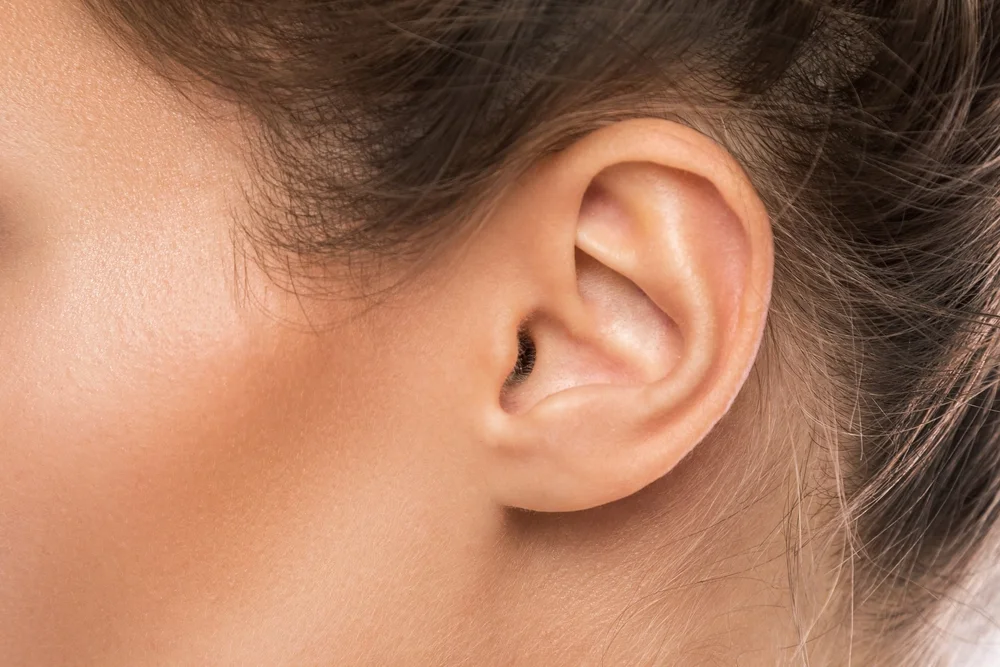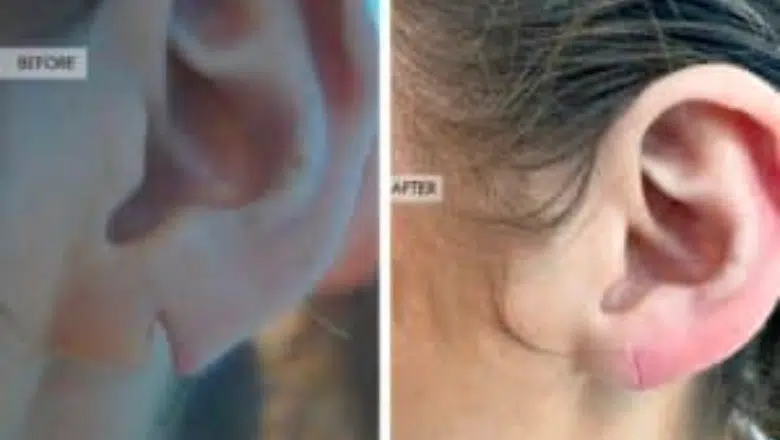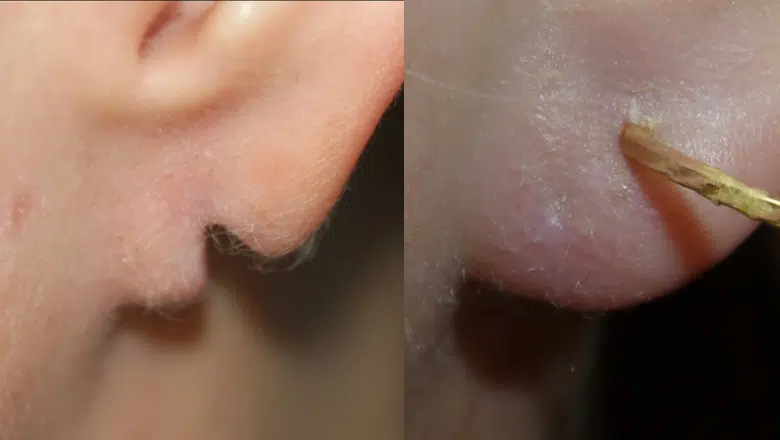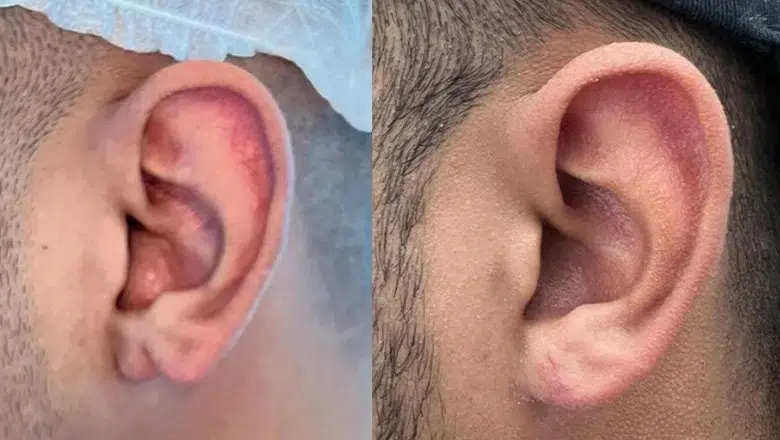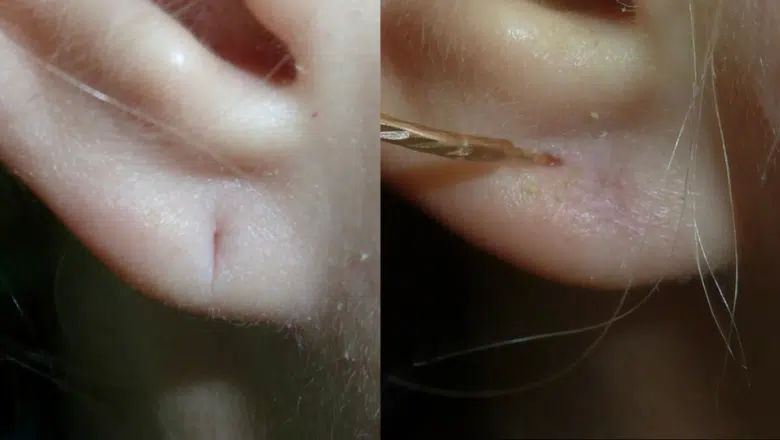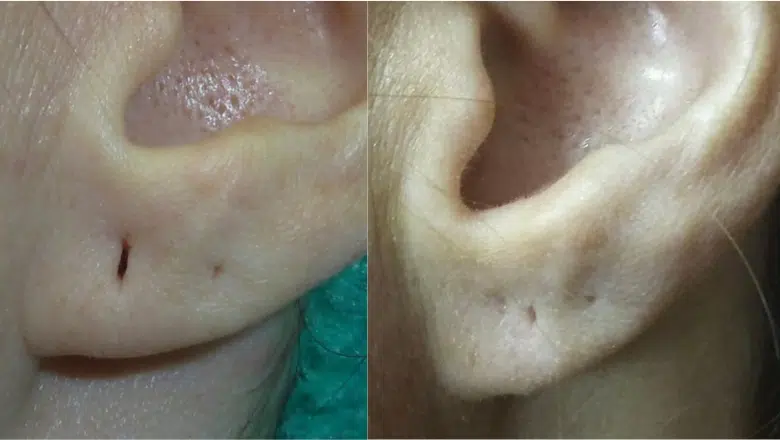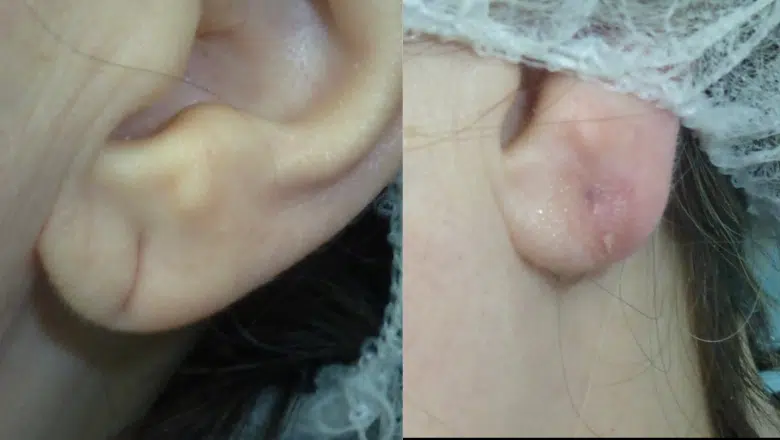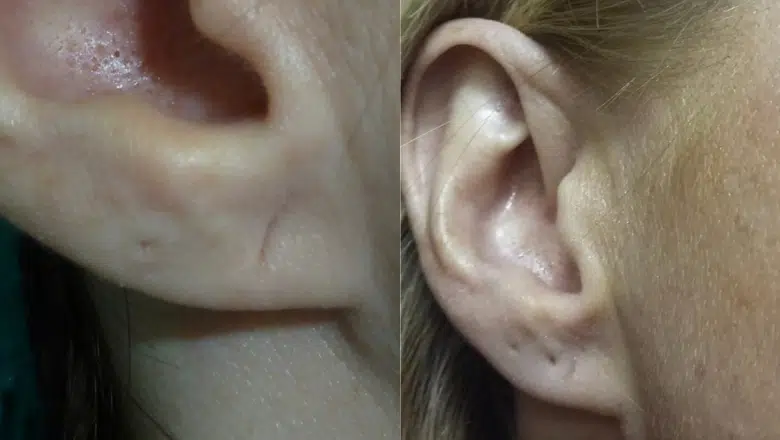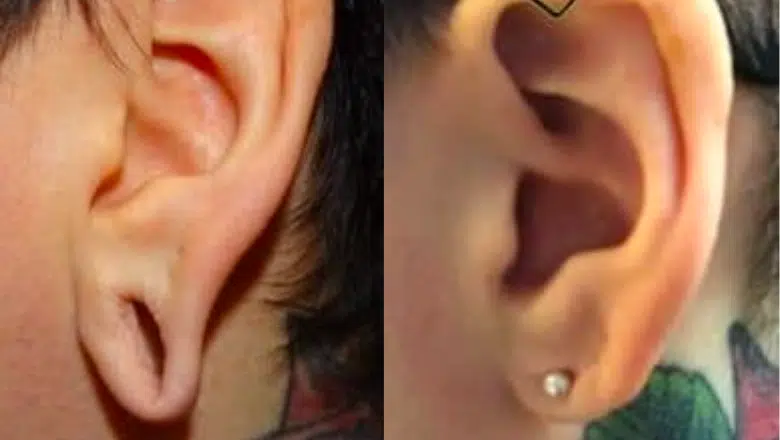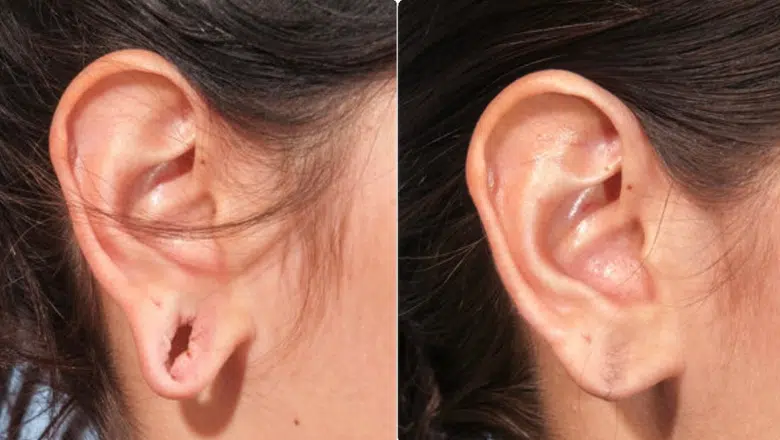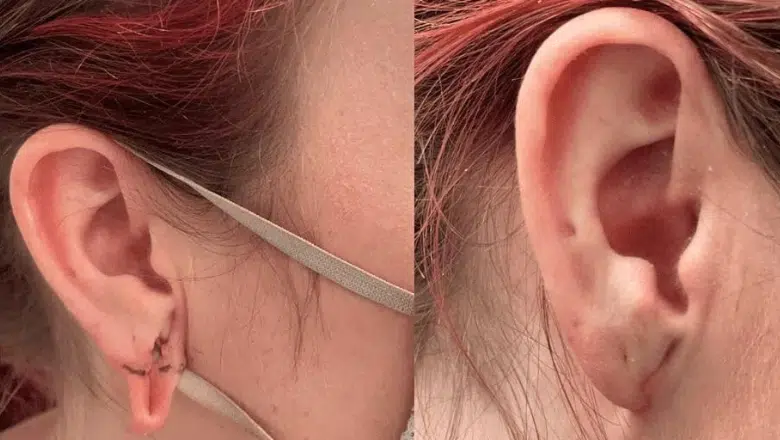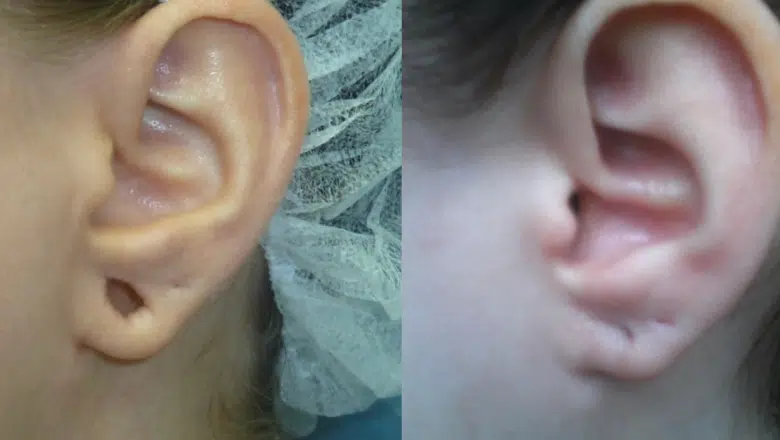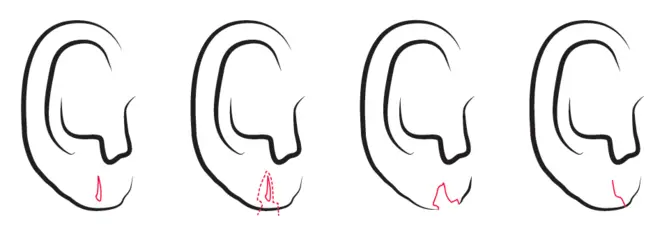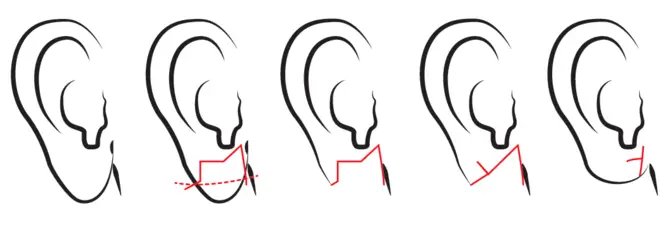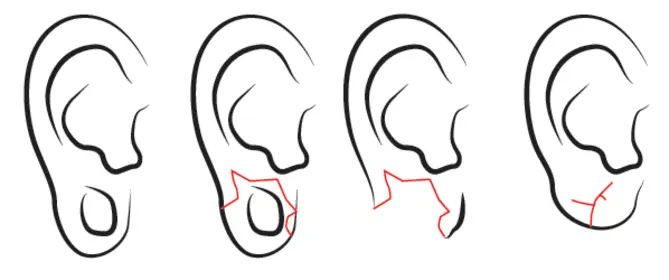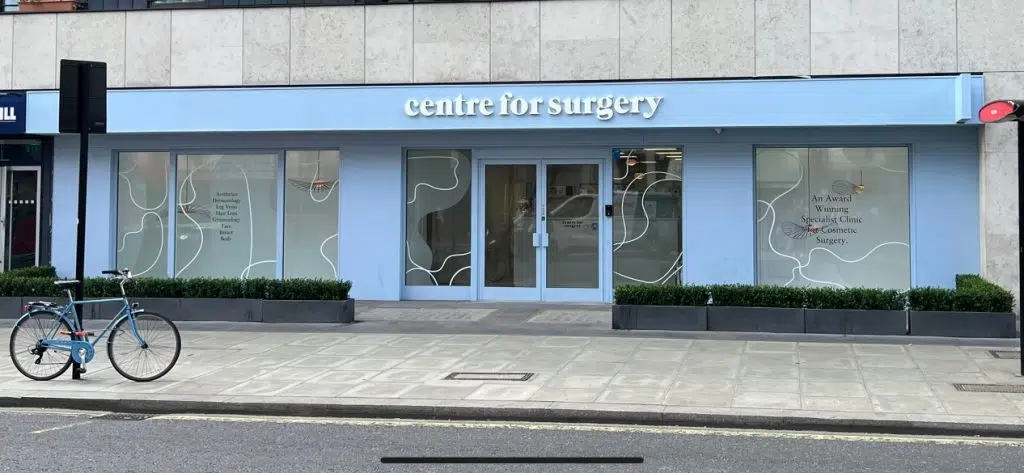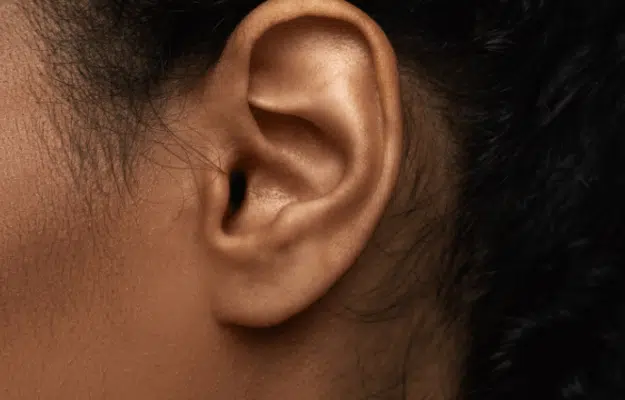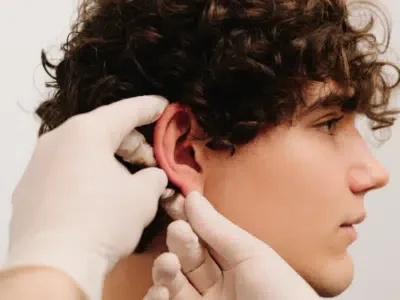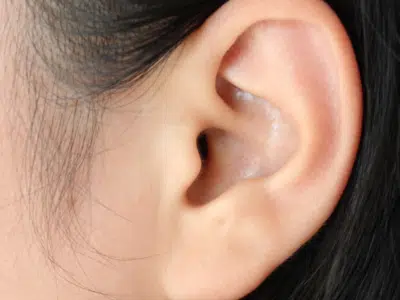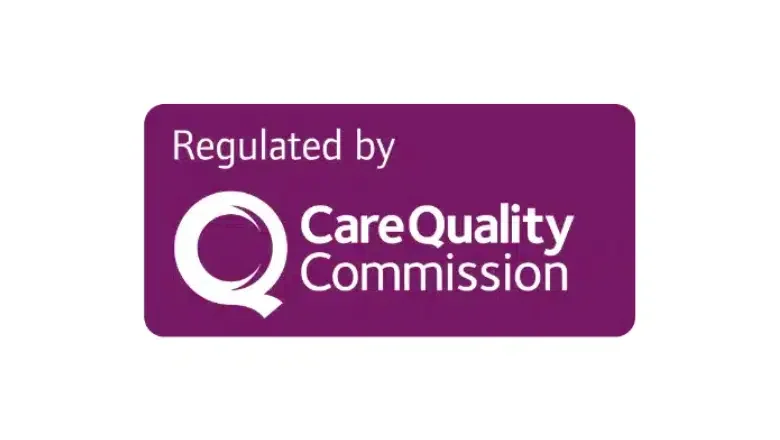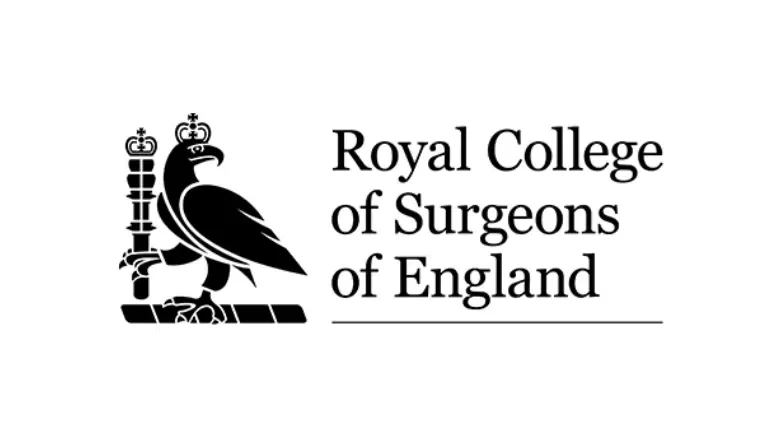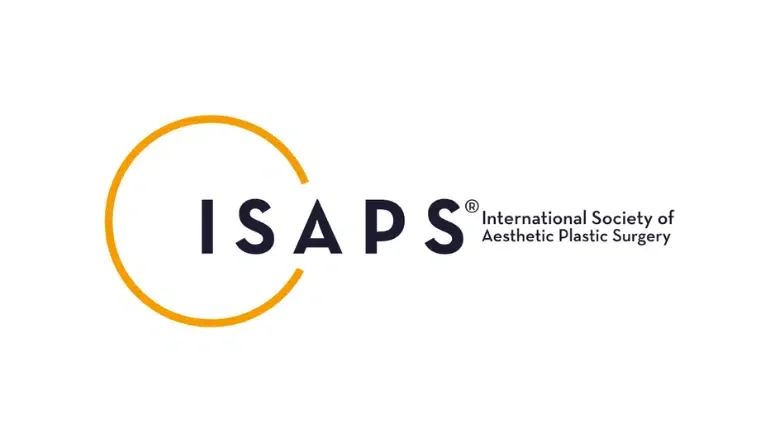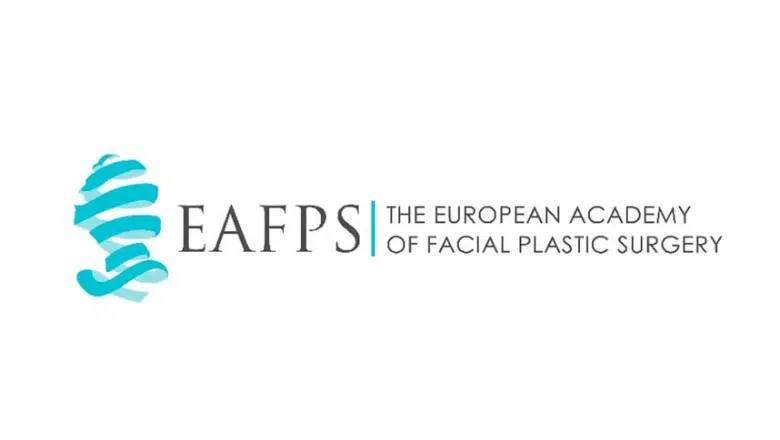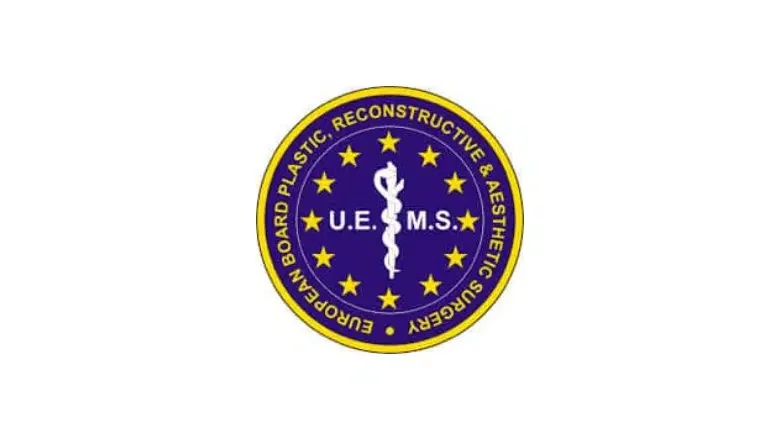Earlobe Repair Surgery London & UK
The ears play a fundamental role in maintaining facial proportions and symmetry. The earlobe is easily prone to injury from traumatic insults or earrings. Problems with the earlobe are surprisingly common. Although seen as relatively trivial, they can exert a disproportionately negative effect on self-image and confidence. Fortunately, earlobes can be easily repaired. Earlobe repair surgery is also often referred to as a lobuleplasty.
RELATED: What are the benefits of split earlobe repair?
Earlobe repair is a safe and effective way to correct ears that have been stretched, split or torn by tribal piercings or other earrings. This commonly happens when an ear piercing, sometimes referred to as flesh tunnels, gradually increases its diameter. This is a suitable procedure for men and women with stretched earlobes.
Some people are not happy with the size of their earlobes because they feel that they are too large. In these cases, an earlobe reduction can be performed by removing excess earlobe tissue. When deciding to have earlobe repair, you must consult with a specialist plastic surgeon who has experience in these kinds of repairs.
Expected results after earlobe repair
- Surgical correction of earlobes that have split, stretched, torn or enlarged.
- Surgical correction of earlobes that are abnormal in shape.
- Patients can have hairstyles that do not conceal the ears, giving them renewed confidence.
- Ability to wear a full range of earrings without the risk of them falling out
| Earlobe repair | Fast facts |
|---|---|
| Procedure time ⏳ | 30mins-1 hour |
| Anaesthetic type 💉 | LA |
| Length of stay 🛏 | Day case |
| Up and mobile 🚶🏻♂️ | Same day |
| Washing 🛁 | 3 days |
| Sexual activity ❤️ | 1 week |
| Back to work 📅 | Same day |
| Driving 🚗 | Same day |
| Postoperative garment 👕 | No garment |
| Sleeping 😴 | On back 1 week |
| Exercise 🏃🏽♀️ | 3 days |
| Full recovery 🕺🏻 | 4 weeks |
| Final results 😃 | 6 weeks |
What is Earlobe Repair Surgery?
Earlobe repair, also referred to as earlobe reconstruction surgery, caters to those with altered earlobes due to injury, trauma, or fashion decisions such as wearing heavy earrings or gauging. Although earlobes that have split don’t typically heal by themselves, surgical intervention can successfully restore and enhance their appearance. Post-surgery, patients can once again enjoy adorning their ears with earrings. There are several specific earlobe repair procedures, each tailored to address different issues:
Earlobe Reduction
Addressing Overstretched Earlobes
Some individuals may find that their earlobes have become elongated over time, which can lead to feelings of self-consciousness. The reasons behind this change can be numerous, including the natural ageing process, inherited traits, or a gradual decline in skin firmness.
The Surgical Solution
To remedy this, earlobe reduction surgery is performed. The procedure involves removing a small portion of the earlobe that borders the cheek, followed by a careful reshaping of the lobe to achieve a smaller, more proportional size. This operation can significantly rejuvenate one’s appearance, with the incisions strategically placed to be as inconspicuous as possible.
Repairing Earlobes After Spacers
From Spacers to Restoration
Many who opted for earlobe spacers or gauges during their younger years may eventually wish to revert to unmodified earlobes. The process begins with the gradual reduction of spacer size, eventually reaching a point where surgical intervention becomes necessary.
Procedure and Recovery
The surgery to repair earlobes stretched by spacers is commonly conducted under local anaesthesia, meaning patients are awake but the area is numbed. The recovery period is relatively short, with most individuals able to return to their routine, including work, within approximately one week.
Mending Ripped Earlobes
Common Causes of Earlobe Tears
Ripped earlobes often result from sudden accidents involving earrings or other forms of ear trauma. Such rips are among the most prevalent earlobe issues faced by individuals today.
Simple Surgical Correction
Fortunately, the repair is relatively uncomplicated. The surgery aims to mend the tear, allowing the earlobe to heal seamlessly. Following a brief healing period, patients can resume wearing earrings without any noticeable sign of the previous rip.
Ear Trauma Reconstruction
Injuries Leading to Ear Surgery
Serious ear injuries can occur due to various reasons, such as vehicular accidents or as a consequence of cancer treatments affecting the ear’s appearance.
Consultation and Restoration
Once any acute injuries have healed, individuals can consult with a plastic surgeon at a specialised clinic like Centre for Surgery. During this consultation, they can explore the available surgical options to restore their ears’ appearance, aligning with their personal aesthetic goals. This bespoke approach ensures that each patient receives care tailored to their specific situation, ensuring the best possible outcomes for ear trauma reconstruction.
Earlobe repair before and after
Split earlobe repair:
Incomplete Split Earlobe Repair:
Stretched earlobe repair:
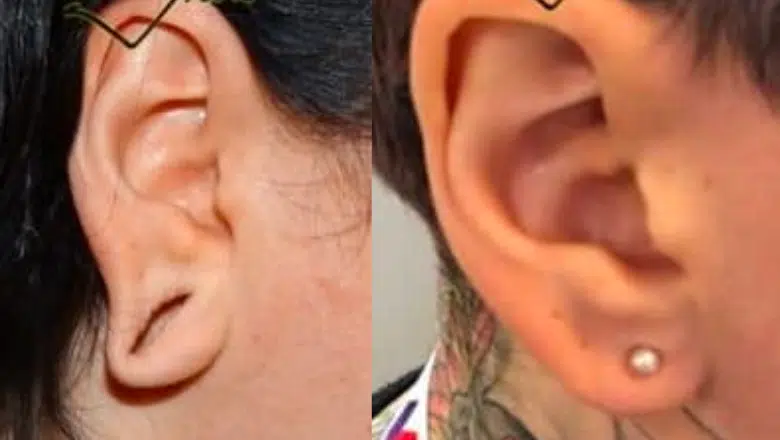
Causes of Earlobe Trauma
Earlobe trauma can arise from a multitude of sources, ranging from lifestyle choices to uncontrollable natural factors. Understanding these can help prevent damage or help you seek timely treatment.
The Weight of Fashion
Heavy Earrings and Earlobe Stretching
A prevalent cause of earlobe damage stems from the habitual wearing of heavy earrings. Over time, the weight of these accessories can stretch the earlobe’s skin, leading to elongation and sometimes even tearing.
Technological Impact
Earplugs and Their Long-Term Effects
Regular use of earplugs, especially if they’re not fitted properly, can exert unnecessary pressure on the earlobes. This continuous strain might not only cause discomfort but also contribute to the deformation of the earlobe over extended periods.
The Role of Heredity and Aging
Inherited Earlobe Characteristics
Genetics can play a significant role in the size and shape of earlobes. Some individuals may naturally have larger, more pendulous earlobes that are prone to stretching and damage as they age.
Physical Interactions
Stretching, Tugging, and Pulling
Activities that involve the stretching, tugging, or pulling of the ears, whether during sports, play, or due to habits like fiddling with earrings, can cause immediate and sometimes long-term damage to the earlobes.
Accidental Tears
Rips and Splits
Earlobes are particularly susceptible to being ripped, whether from snagging an earring on clothing or through a sudden pull. Such accidents can result in a split that might require surgical repair if not addressed promptly.
Circulatory Concerns
Restricted Blood Flow
Any condition or situation that limits blood flow to the earlobes can lead to tissue damage. This includes tight earrings, certain medical conditions, or even sleeping positions that place prolonged pressure on the ears. Regular monitoring and care are essential to maintain earlobe health and prevent such occurrences.
Earlobe repair specialists
Centre for Surgery strives to provide every patient with the very highest standard of care. Our plastic surgeons constantly learn about the latest techniques at international conferences to apply to patient care. The expert surgical methods combined with many years of experience result in earlobe repair results that look beautiful and natural-looking and are in harmony with overall facial aesthetics. Centre for Surgery differs from other providers in that our surgeons are sub-specialists and only perform a select range of procedures in which they are recognised as accredited experts.
If you are interested in earlobe repair, why not book a face-to-face consultation with one of our specialist earlobe surgeons? Our surgeons will take time to assess you in full, including selecting the most suitable method of repair customised to your unique needs and preferences. If you wish, a selection of earlobe repair before and after photos of real patients can be shown, what you can expect in terms of results and answer all your questions in detail.
Split and stretched earlobe repair
Expected Results after Earlobe Repair
- Correction of earlobes that have been torn, split or stretched
- Congenital correction of earlobes that were abnormally shaped from birth
- Renewed self-confidence to style hair in such a way as to reveal the earlobes
- Freedom to wear all sorts of earrings with no risk of the earrings falling out
Should I have my earlobes repaired?
Large earrings and plugs will create a hole in the earlobe, which becomes bigger as the diameter of the earring is increased. After a certain size, the earlobe will never contract to its original size and shape. The altered earlobe shape is often difficult to hide, particularly for those with shorter hair.
Sometimes the stretched or split earlobe will negatively impact your appearance and, in some instances, your work or career. In these cases, earlobe repair surgery is an appropriate option.
Dangers of ear stretching
- It can cause an ‘ear blow-out’, which happens when the skin inside of the earlobe is forced out through the back of the piercing
- Earlobe repair is the only option for stretched ears to go back to normal
- Can cause physical pain
Am I suitable?
Earlobe repair surgery is a safe and effective procedure for individuals who have experienced a split or torn earlobe due to trauma, injury, or wearing heavy earrings over time. In general, ideal candidates for earlobe repair surgery include:
Individuals with split or torn earlobes
Earlobe repair surgery is primarily used to correct split or torn earlobes, which can occur due to various reasons, including injury or prolonged wear of heavy earrings.
Individuals in good overall health
As with any surgical procedure, it is important that patients are in good overall health and do not have any underlying medical conditions that could increase the risk of complications.
Non-smokers
Smoking can increase the risk of complications during and after surgery, so it is recommended that patients refrain from smoking for several weeks before and after the surgery.
Individuals with realistic expectations
It is important that patients have realistic expectations for the results of the surgery and understands that the goal of earlobe repair surgery is to restore the natural appearance of the earlobe, rather than to achieve perfection.
Individuals who are committed to postoperative care
Proper postoperative care is essential to ensure the best possible healing and minimise the risk of complications. Patients must be willing to follow their surgeon’s post-operative instructions carefully and attend all follow-up appointments.
Preparation for earlobe repair
Earlobe repair can be performed on a ‘see and treat’ basis on the same day as the consultation provided our patient coordinators are informed of your preference at the consultation booking stage. The earlobe repair procedure is performed under local anaesthetic as an outpatient. After earlobe repair surgery, you must follow all the necessary postoperative instructions to ensure a smooth recovery.
You should avoid taking aspirin-containing medicines before the procedure for at least one week beforehand. You should also avoid smoking and drinking alcohol for a minimum of 48 hours beforehand, as smoking tobacco and alcohol impair the wound healing process.
If you have the procedure under local anaesthetic only (with no oral sedation), you may drive home afterwards.
Earlobe Repair Surgical Techniques
There are several techniques that can be used in earlobe repair surgery, and the best technique will depend on the extent and location of the injury.
Simple Closure
Simple closure is the most common technique used for repairing a split or torn earlobe. This technique involves making a small incision to remove any excess tissue and then carefully stitching the edges of the earlobe back together. The stitches used in this technique are typically dissolvable and do not need to be removed.
Z-plasty
Z-plasty is a technique that can be used to repair earlobes with a diagonal or irregular tear. This technique involves making diagonal incisions in the surrounding tissue and then repositioning the tissue to create a Z-shaped pattern. The new shape of the earlobe helps to improve the appearance and minimize scarring.
Wedge Excision
Wedge excision is a technique that can be used to repair earlobes with a larger or more complex tear. This technique involves removing a small wedge-shaped section of tissue from the earlobe and then carefully stitching the edges back together.
Lobe Recontouring
Lobe recontouring is a technique that can be used to correct elongated or stretched earlobes. This technique involves removing excess tissue and then reshaping the earlobe to create a more aesthetically pleasing appearance.
Our surgeons reconstruct all types of earlobe deformities using meticulous plastic surgery techniques.
- Split earlobe repair
- Stretched earlobe repair
- Tribal earlobe repair
Earlobe repair – step by step
Here is a step-by-step description of an earlobe repair surgery:
Anaesthesia
The patient is given local anaesthesia to numb the earlobe, which will ensure that the patient does not feel any pain during the procedure.
Cleaning the earlobe
The surgeon cleans the earlobe with an antiseptic solution to reduce the risk of infection.
Incision
The surgeon makes a small incision on the earlobe to access the area that needs to be repaired.
Tissue removal
The surgeon removes any excess tissue or debris from the area of the earlobe that has been damaged or torn.
Stitching the earlobe
The surgeon then carefully stitches the edges of the earlobe back together, using either a simple closure technique or a more complex technique such as Z-plasty or wedge excision.
Dressing
The surgeon places a dressing over the earlobe to protect it and ensure proper healing.
Postoperative care
The surgeon will provide instructions on how to care for the earlobe after the procedure. This may include keeping the area clean and dry, avoiding strenuous activities, and taking any prescribed medications.
The entire earlobe repair procedure typically takes less than an hour to complete, and the patient can usually go home the same day. The earlobe may be sore and swollen for a few days after the procedure, but most patients can resume normal activities within a short period. With proper care, the earlobe can heal and regain its natural appearance.
Recovery after earlobe repair surgery
Earlobe repair is a procedure with very little discomfort. The recovery period is characteristically expeditious. Your surgeon may prescribe you a special antibiotic ointment to apply to the earlobes or a special brown tape may be applied to the earlobes, which is dependent upon the surgical techniques employed.
In most cases, there is no discomfort, but your surgeon may recommend over-the-counter painkillers in the event of any prolonged soreness. Bruising and swelling are temporary phenomena expected to disappear in a few weeks after the procedure. Once the repair is fully healed, you can have your ears re-pierced.
You should avoid wearing polar neck jumpers or pressing your phone close to your earlobe for about a week after the procedure. You should also avoid direct sun exposure to the area and avoid the use of harsh soaps to facilitate excellent healing. It is perfectly fine to return to work straightaway – there is no downtime with earlobe repair surgery. However, you may wish to consider having your procedure at the end of the week to allow some rest over the weekend.
When can I re-pierce my ears after earlobe repair?
The timing for repiercing the ears after earlobe repair surgery can vary depending on the extent of the surgery and the individual’s healing process. In general, it is recommended that patients wait at least six weeks after the surgery before repiercing their ears.
During the healing process, the earlobe may be sore and swollen, and it is important to avoid putting pressure on the earlobe or wearing any earrings that could interfere with the healing process. Repiercing the ears too soon can delay the healing process or cause further damage to the earlobe.
Once the six-week period has passed, it is important to choose high-quality, hypoallergenic earrings that are appropriate for newly pierced ears. Patients should avoid wearing heavy earrings or anything that could put pressure on the earlobe for several weeks after repiercing.
Follow the surgeon’s post-operative instructions carefully and wait until the earlobe is fully healed before repiercing the ears. This can help to ensure the best possible healing and minimize the risk of complications.
Understanding the Possible Risks and Complications of Earlobe Surgery
Earlobe surgery is generally seen as a low-risk operation, but as with any surgical intervention, it carries certain inherent risks and possible complications. Opting for a skilled surgeon and adhering strictly to their advice before and after the surgery can significantly enhance your recovery. Below, we discuss some complications that, while typically rare, could occur:
Infection Risk
Infections following earlobe surgery don’t frequently occur, but they are a possibility. To minimise this risk, it’s crucial to use any topical ointments provided and take any medications your surgeon prescribes. It’s essential to keep the surgical area clean and sterile.
Hematoma or Bleeding
Very occasionally, patients might experience a hematoma, which is when blood collects in the ear, causing swelling. Should this happen, your surgeon can address the issue by draining the accumulated blood.
Protruding Stitches
Sometimes, especially with permanent sutures that might be used behind the ears, there’s a chance they could begin to poke through the skin and become visible. This issue can be resolved by removing the stitches if it becomes a problem.
Overcorrection Issues
Overcorrection refers to when the ear is attached too tightly to the head, and it’s a problem that can happen. It’s often addressed by inserting cartilage grafts, which allow the ear to reposition itself more naturally. In some cases, additional surgery may be needed to correct this.
Under correction Concerns
If the earlobe surgery results in under-correction—meaning the ears still stick out more than desired—it’s usually a simpler fix than overcorrection. This can typically be corrected in the surgeon’s office with a minor procedure under local anaesthesia.
Gradual Reversal Over Time
Since ear tissue is largely composed of elastic cartilage, there’s a long-term possibility that the ears may slowly move back towards their original position. This reversal is a rare occurrence, but if it does happen, revision surgery is an option.
Cost of ear lobe repair
There are a number of factors which will impact the final cost of your earlobe repair procedure:
- Primary or revision earlobe repair
- One or both earlobes
- Complex corrections such as tribal earlobes
- Earlobe reduction
Why not call 0207 993 4849 and speak to one of our expert patient coordinators, who can give you a rough costing before your earlobe repair procedure?
Remember that price should never be the determining factor when choosing your provider. We feel that safety and quality of service should be your number one priority and instil in you the confidence that our team will look after you before, during and after your procedure to the best of their ability.
Why choose Centre for Surgery for Earlobe Repair?
Centre for Surgery is a plastic surgery clinic committed to providing all our patients with the highest standards of medical care. Our specialist plastic surgeons are always learning to keep abreast of the latest advances in their practice field. This ensures patients get optimal results. With the use of microsurgical techniques combined with years of experience, all our earlobe repair patients can achieve natural earlobes in overall facial harmony.
Our surgeons are recognised sub-specialists, and we believe this helps to achieve superior outcomes compared with general plastic surgeons. By performing a smaller number of procedures extremely well, outcomes are better compared with surgeons who perform lots of different procedures less frequently.
What is included in my treatment package?
- As many preoperative consultations with your surgeon as you like to make sure the procedure is right for you
- Treatment at a specialist day surgery facility recently rated ‘Good’ by the CQC
- Enhanced same-day discharge with the added benefits of recovering in your own home
- 24/7 clinical support from your surgeon for the first 48 hours and our expert postoperative support team
- Your very own dedicated patient coordinator
- In-depth preoperative medical assessment to make sure you are fully fit for the rhinoplasty procedure
- Exceptionally high standards of postoperative care are described as ‘outstanding’ by the CQC, with regular telephone and face-to-face checks by our expert postoperative support team.
RealSelf Top Doctors for earlobe repair
RealSelf’s top doctor status is awarded to less than 10% of the RealSelf doctor community. This status is earned by achieving consistently high patient satisfaction (from RealSelf reviews), getting excellent feedback on expert answers to patient questions, and investing significant time in Q&A and other doctor activities. RealSelf’s top doctors are rated among the very best surgeons in the UK.
If you are interested in earlobe repair, we recommend booking a private consultation with one of our specialist plastic surgeons. Our surgeons will take time to assess you carefully and fully and then advise the most earlobe repair technique to get optimal results.
RELATED: Earlobe Surgery Near Me
FAQs
-
When should I have earlobe repair surgery?You need an earlobe repair surgery if you feel that stretched or split earlobes are affecting your appearance impacting your work and career, the earlobe repair surgical team at Centre for Surgery can provide a full range of surgical treatment options.
-
Can stretched earlobes revert to their original shape without surgery?Slightly stretched earlobes often return to their normal shape over time. However, for earlobes that have been significantly stretched, surgery is the only option to restore their original appearance as they won't shrink back naturally.
-
Is it possible to stitch a torn earlobe?Absolutely, torn earlobes can be repaired by a plastic surgeon. The usual method involves removing the torn skin and then stitching the fresh edges of the wound together with sutures that dissolve over time.
-
Can all earlobe issues be corrected surgically?Yes, plastic surgery can resolve almost all types of earlobe problems, whether they are due to stretching, tearing, or other damage.
-
Is it possible to have detached earlobes reattached?Yes, surgery can reattach earlobes that have become detached, restoring them to their original state.
-
How can a split ear hole be repaired?The most effective way to repair a split ear hole is through earlobe surgery, where the split parts are joined together again.
-
What causes the skin behind the ear to split?Dryness and irritation are common culprits for skin splitting behind the ears. This can cause the skin to become cracked and may lead to skin conditions.
-
What's the reason for wrinkled earlobes?Wrinkled earlobes can be caused by a breakdown of the elastic tissues around the blood vessels that supply blood to the area, often due to ageing.
-
How can wrinkled earlobes be treated?Wrinkled earlobes can be rejuvenated with treatments such as dermal fillers, which help to smooth, plump, and lift the earlobes, giving them a more youthful look.
-
What does a crease in my earlobe signify?A crease in the earlobe can sometimes indicate that there is a reduced blood supply to the area, which is often a result of weakened blood vessels and the natural ageing process.
-
What should be done if an earring hole tears through?If an earring hole tears through, it results in a split earlobe. To fix this, plastic surgery is necessary to repair the tear and make the earlobe whole again.
-
What does earlobe repair involve?Earlobe repair is a surgical procedure used to fix earlobes that have been damaged. This damage might be due to various reasons such as injuries, the impact of piercings, stretching from heavy earrings, or the intentional expansion of earlobes using gauges.
-
How is earlobe repair surgery performed?Anaesthesia: The surgeon will begin by administering local anaesthesia to numb the earlobe and surrounding area.
Cleaning the earlobe: The surgeon will clean the earlobe with an antiseptic solution to reduce the risk of infection.
Incision: The surgeon will then make a small incision to remove any excess tissue or debris from the area of the earlobe that has been damaged or torn.
Stitching the earlobe: The surgeon will carefully stitch the edges of the earlobe back together using a fine suture material. The stitches used are typically dissolvable and do not need to be removed.
Dressing: The surgeon will place a small dressing over the earlobe to protect it and ensure proper healing.
Post-operative care: The surgeon will provide instructions on how to care for the earlobe after the procedure. This may include keeping the area clean and dry, avoiding strenuous activities, and taking any prescribed medications.
The entire earlobe repair procedure typically takes less than an hour to complete, and the patient can usually go home the same day. The earlobe may be sore and swollen for a few days after the procedure, but most patients are able to resume normal activities within a short period of time. With proper care, the earlobe can heal and regain its natural appearance. -
How is earlobe surgery done?Repairing a damaged earlobe involves a series of steps carried out by a surgeon. First, they'll prepare the ear by cleaning the area and then applying a local anaesthetic to numb it. If the earlobe is torn or stretched, the surgeon will carefully remove any scar tissue and then trim the edges of the tear to create fresh surfaces for reattachment. Once this is done, they'll stitch the earlobe back together with fine sutures. These stitches are usually quite small and will either dissolve on their own or be removed after a short period, depending on the type used. The goal is to restore the natural shape of the earlobe and allow it to heal smoothly, so you can return to wearing earrings or simply enjoy the look of your restored earlobe.
-
What anaesthetic is used?Earlobe repair is performed under a local anaesthetic. This means you will be awake during the procedure but unable to feel any discomfort in the treatment area.
-
Is earlobe repair surgery painful?When you undergo an earlobe repair, you shouldn't feel any pain during the surgery itself. This is because the area will be numbed with a local anaesthetic. You might feel a bit of pressure or movement, but no actual discomfort. After the anaesthesia wears off, it's normal to experience some soreness or discomfort. Your surgeon will likely recommend or prescribe pain relief medication to help manage any pain in the days following the surgery.
-
How long does earlobe repair take?The length of time it takes to perform an earlobe repair surgery can vary depending on the extent of the injury or damage to the earlobe. In general, the procedure can be completed in about 30 minutes to an hour.
Earlobe repair is typically performed as an outpatient procedure, which means that the patient can go home the same day as the surgery. The procedure is usually performed under local anesthesia, which numbs the earlobe and surrounding area, so the patient should not experience any pain during the procedure.
-
Does earlobe repair hurt?Earlobe repair surgery is typically performed under local anesthesia, which numbs the earlobe and surrounding area. As a result, patients generally do not feel any pain during the procedure.
After the surgery, patients may experience some discomfort, swelling, and tenderness in the earlobe area, but this can usually be managed with pain medication prescribed by the surgeon. Most patients are able to resume normal activities within a few days to a week after the surgery. -
What will my recovery be like following earlobe surgery?After you've had earlobe surgery, it's quite common to experience a bit of discomfort, some swelling, and perhaps a little bruising around the area that was treated. These symptoms are usually nothing to worry about and should start to get better after several days.
-
How long will the stitches need to stay in after the procedure?The stitches that are put in place following your earlobe surgery are usually taken out after one to two weeks. This allows enough time for the area to start healing properly.
-
Are there any risks associated with earlobe repair surgery?The complications linked to the procedure are minimal. Most common risks usually are infection, excessive scar formation, and notching, but these can be minimised with maximum safety optimisation.
-
Will I be left with scars?There will be small scars on the ears which will look red after the surgery, but will eventually fade to a pale silvery colour. The earlobe should look almost completely normal with no obvious signs of the previous piercing after 4-6 months.
-
What's the best way to sleep after I've had earlobe surgery?For the initial few days after your surgery, it's advisable to sleep in a reclining chair if you can. This position helps to avoid any unnecessary pressure on the earlobes. If you don't have a recliner, make sure to lie on your back in bed and keep your head and shoulders propped up. The key is to keep your head elevated and to not rest directly on the operated area.
-
When is it safe to start wearing earrings again after earlobe repair?You'll need to wait until your earlobes have fully healed before you start wearing earrings again. This healing process generally takes around 12 weeks. After this period, you can enjoy wearing earrings once more.
-
Why is it important to stay out of the sun during the healing phase?Prolonged exposure to sunlight can cause hyperpigmentation of the the incision lines. Our doctors therefore recommend staying out of direct sunlight for at least one week after the procedure.
What To Expect
The consultation
After you have decided to learn more about earlobe repair, we would recommend a face-to-face consultation with one of our expert earlobe repair surgeons as the first step in your journey towards achieving a full aesthetic earlobe correction. When you meet with one of our surgeons, your surgeon will listen carefully to what you hope to achieve and give you an expert opinion on what can and cannot be achieved after performing a thorough physical examination of the ears.
Your surgeon will also take several measurements for a detailed facial analysis. Finally, high-resolution photographs are taken from several views of the ears from different angles. Your surgeon will also discuss the potential risks and complications of earlobe repair and what to expect in the postoperative phase during your healing and recovery. It is important to know what medicines you are taking as some can interfere with blood clotting and may need to be stopped. Any history of medical conditions or previous surgery will also be recorded, and all the compiled information will be used to decide on your medical fitness for the split earlobe repair procedure.
After a recommended two-week cooling-off period and provided you are appropriate for the procedure, you can then decide whether you would like to proceed with the procedure. If you are unsure about any aspect of the procedure and what it entails, we invite you to return for as many follow-up consultations with your surgeon as you like to ensure that earlobe surgery is right for you. The consultation lasts about 30 minutes on average. It may take longer if your procedure is going to be more complex. We would actively recommend attending a follow-up consultation to ensure all your questions are answered.
Before your procedure
Once you have decided to proceed with earlobe repair surgery, our preoperative assessment team will be in touch to assess medical fitness before coming in on the day of surgery. Before your procedure, there are several instructions to follow, including stopping any aspirin-containing medicines as these can increase bleeding and, ideally, stopping smoking. Smokers have a higher risk of slower wound healing and more chance of wound complications. On the day of your procedure, you will have a local anaesthetic, so there is no requirement to fast beforehand.
On the day of your earlobe repair procedure
When you arrive for your earlobe repair procedure, you should aim to arrive on time to allow the admission process to proceed smoothly. One of our nurses will formally admit you and check several items, including ensuring you have your postoperative medications. Your vital signs will be measured, including blood pressure and heart rate. Finally, your surgeon will speak to you before the procedure, followed by a detailed preoperative marking of the earlobes to be treated.
The earlobe repair procedure takes about 30 minutes to 1 hour and is easily performed under a local anaesthetic with or without oral sedation to relax you. The surgeon will first inject the ear lobes with a local anaesthetic to numb the area. Incisions will then be made to expose the earlobe for reshaping. The incisions can be located on the front or back of the earlobe, depending on the degree of correction required. The surgeon will gently separate the redundant earlobe skin. The earlobe repair technique used in your procedure depends on what will be achieved. Once the earlobe has been reshaped, the new position is carefully secured with non-absorbable sutures. There is no need to wear a postoperative support garment. Any scarring from earlobe repair is very minimal.
After the procedure, you will spend time in our recovery suite, where you will be prepared for nurse-led discharge once you have met all the discharge criteria. If you have oral sedation, it is important to have a responsible adult accompany you home and look after you for the first 24 hours.
After your procedure
Once you are safely home, you can be assured of access to our specialist postoperative team around the clock. If there is any concern, you will be given a contact number to contact your surgeon in the first 24 hours after surgery. An earlobe repair procedure is associated with minimal postoperative discomfort, although some discomfort is common for the first week after surgery. Bruising should start to subside after 7-10 days. You should avoid intense sunlight after the procedure to reduce the risk of pigmentary changes.
Our postoperative team will look to call every day for the first two weeks after your procedure. This is so we can monitor your levels of comfort and can alert your surgeon if there is any concern. Our proactive approach allows early detection of potential issues, resulting in more effective treatment. Heavy exercise should be avoided for at least the first week. Our postoperative clinical team will assess you at your 1-week postoperative appointment to ensure healing is progressing normally and the wound site is healthy. A wound check is performed at this time to make sure the wound is healing normally. You will be booked for your surgeon's follow-up appointment six weeks after your procedure.


